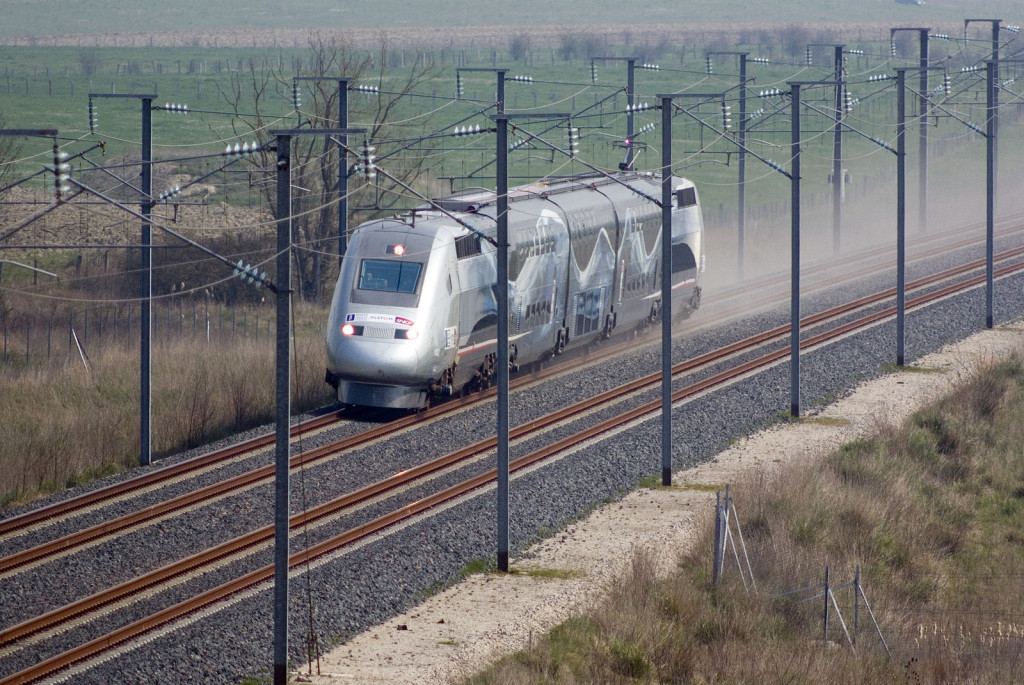
TGV 4402 (operation V150) reaching 574 km/h on 3 April 2007 near Le Chemin
On April 3, 2007, the French V150, a specially configured TGV high-speed train, broke the world land speed record for conventional railed trains and reached a speed of 574.8 kilometres per hour (357.2 mph) on an unopened section of the LGV Est between Strasbourg and Paris, in France.
A Brief History of Railway Speed Records
A first speed record was set by the first really serviceable locomotive, the Rocket by George Stephenson, in 1830, which ran at 48 km/h. Then in 1890 a French Crampton reached 144 km/h.[6] The 200 km/h mark was exceeded for the first time on 6 October 1903 during a trip on the Marienfelde-Zossen-Jüterbog military railway with an electrically operated railcar from AEG and Siemens & Halske, which finally reached 210.3 km/h on 27 October 1903. Steam locomotives also ran faster than 200 km/h: On May 11, 1936 the express locomotive 05 002 on the Berlin-Hamburg line reached 200.4 km/h, a record which was broken only two years later by the British LNER Class A4 No. 4468 Mallard at 202.6 km/h. But already on June 21, 1931, Franz Kruckenberg‘s rail zeppelin had reached 230.2 km/h, a record that lasted for 24 years.[7] On 29 March 1955, the French CC 7107 locomotive broke through the 300 km/h mark for the first time at 326 km/h, and one day later the BB 9004 broke through the 300 km/h mark at 331 km/h; a record that lasted for 26 years. The next record holder was the TGV PSE 16, which reached 380 km/h on the Paris-Lyon line on 26 February 1981. The 400 km/h mark was exceeded for the first time on 1 May 1988 on the high-speed Hanover-Würzburg line with 406.9 km/h with the ICE-V. On 18 May 1990 the French TGV set a new record of 515.3 km/h.
The French V150
The 150 in V150 refers to a target speed in metres per second. It was a series of high speed trials carried out on the LGV Est prior to its June 2007 opening. Following a series of increasingly high speed runs, the official speed record attempt took place on 3 April 2007. The top speed of 574.8 km/h was reached at kilometer point 191 near Le Chemin. The 515.3 km/h speed record of 1990 was unofficially broken multiple times during the test campaign, the last time was on 15 April 2007 with a speed of 542.9 kilometres per hour.
Technical Details
The train had four more powered axles than trainset 325 used in the 1990 speed record, and had a maximum power output of 19.6 MW (26,300 hp) instead of the 9.3 MW (12,500 hp) on a standard TGV POS. This unusual composition was used to obtain high speed test data on disparate technical elements including the new asynchronous traction motors on the POS power cars, the lightweight synchronous permanent magnet traction motors on the AGV bogies, the actively controlled pantograph, and the Duplex bi-level configuration which had never been used in very high speed trials.
Aerodynamical Improvements
The train’s aerodynamic improvements were refined in a wind tunnel and provided a 15% reduction in drag from the standard configuration. The improvements included a front air dam, roof fairings over the pantograph openings, membranes to cover the space between the cars, and a flush-mounted windshield.
Chased by an Airplane
The train accelerated over a distance of 70 kilometres. During certain runs, including the official record run, the V150 train was chased by an Aérospatiale Corvette airplane to provide data relay and uplink of live television images. After the record trip on April 3, 2007, trips with speeds of at least 520 km/h followed almost every day until April 15, 2007. A total speed of 500 km/h or more was achieved over a length of more than 700 kilometres. At least 450 km/h was the speed of the record train to a total of 3200 km. At the same time, however, the record train remained below the record for track-bound vehicles set in April 2015 by the Japanese magnetic levitation train Shinkansen L0 series at 603 km/h.
TGV Speed Record, via IndianaHighSpeedRail, Youtube [8]
References and Further Reading:
- [1] V150: Power-packed train proves AGV technology in record sprint
- [2] Video of the record being broken
- [3] France celebrates train’s new speed record in Champagne
- [4] V150 train at Wikidata
- [5] TGV makes 574.8 km/h on rails, at WikiNews
- [6] Stephenson’s Rocket winning the Rainhill Trials, SciHi Blog
- [7] Mixing Up a Plane with a Train – Franz Kruckenberg’s Schienenzeppelin, SciHi Blog
- [8] TGV Speed Record, via IndianaHighSpeedRail, Indiana Passenger Rail Alliance @ youtube





